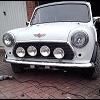Posted 12 January 2014 - 08:05 PM
Yes as you suspected it's a throttle damper. These cars had three separate but related emission control systems, as more modern cars do too but now it's all controlled digitally so it's more straightforward. There is the evaporative loss system (charcoal canister and hoses) that traps and burns fuel vapour from the tank, float bowl and lines. There is the exhaust emission control system that injects air into the exhaust ports to ensures clean burn (more basic and less efficient than a cat but allows more tolerance for the fuel ratio, some cars now have air injection and cats together), and also injects air into the inlet under over-run for the same reason. Then there is the crankcase emissions system as used by later models more or less unchanged. The throttle damper is part of the air injection system and stops the throttle snapping closed too quickly, I believe because the gulp valve that added air to the inlet wouldn't respond as quickly as the throttle would snap closed naturally. This would play havoc with the mixture as you came off the throttle and the car would surge. The damper allows the throttle to close at a rate the gulp valve can match. If you have ripped out the air injection system then the damper isn't needed.
I would personally keep the PCV system in place but you don't need the manifold valve for it. Use a carb with a proper emissions connection and just hose the various breathers to that. If you have just an old carb without an emission port then maybe you are best going back to open breathing because the valves are unreliable when old. Although they can be effectively overhauled it will always be a pain at service. If you do go back to open breathing just don't kid yourself that 'road draught' actually works as advertised and simply accept is as an open vent.
The carb heaters are as you say for cold weather running and well worth keeping. Hopefully you still have an arctic spec heater fitted, as was original.
 DSCN4795.JPG 65.58K
44 downloads
DSCN4795.JPG 65.58K
44 downloads


















